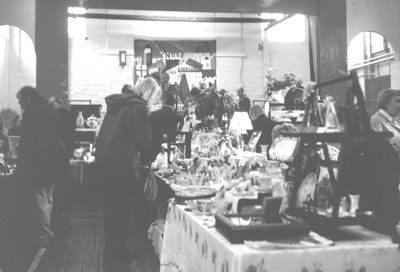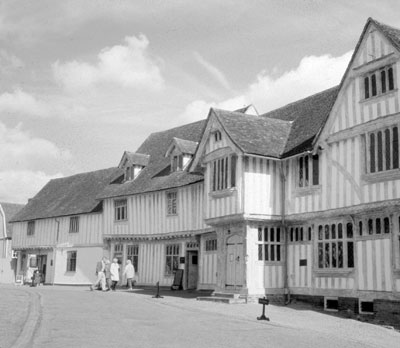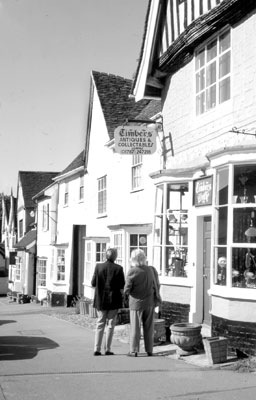Weaving our way through the villages of East Anglia
by Michael Algar, Toronto, Ontario, Canada
Within easy reach of London, some of East Anglia’s landscapes will live forever in Constable and Gainsborough paintings. But it is wealth from this area’s cloth-weaving industries that is reflected in its historic communities of such appeal today.
Choosing an itinerary
From several self-drive themed itineraries available from the East of England Tourist Board (Toppesfield Hall, Hadleigh, Suffolk IP7 5DN; phone 0870 225 4800 or visit www. visiteastofengland.com), we chose one in 2002 that took us into some of England’s most picturesque towns and villages.
Here, the grand dwellings originally built by prosperous cloth merchants are showplaces and museums. Mills have been converted to hotels and restaurants. Cottages house craft and antique shops, so many, in fact, that the BBC-TV “Lovejoy” series (seen in the States on PBS), which gives a lighthearted look at East Anglia’s antique trade, never seems to run out of new locales.
Our particular tour covered approximately 120 miles and could have been accomplished in a day. Instead we allowed three days, from Friday to Sunday, permitting us to see the area at its best while giving us time to browse and generally enjoy the scenery.
In addition, East Anglia’s hotels, in common with many other parts of England, generally offer “weekend getaway” rates which are often half of the listed prices.
Braintree
Flying into Stansted Airport in Essex, northeast of London, we began our tour only 15 minutes away in Braintree. Throughout this region, weavers continue to produce cloth, often using looms that have been in place for the past l00 years or longer. Such are the silk weavers, converting thread imported from China into exquisite fabric which can sell for something like $1,000 a yard. Even at this price, orders are steady from castles and stately homes throughout Europe, where patterned silk is used to cover walls as well as windows. Buckingham Palace has Braintree silk lining salon walls, and the Crown Jewels in the Tower of London are displayed on Braintree velvet.
History of the trade
Silk weaving is a relative newcomer to East Anglia. Craftsmen arrived in the 1830s when Samuel Courtauld, a descendant of Huguenot refugees, came from London to set up shop there.
Braintree was already a thriving market town at the end of the 12th century, shipping raw wool to the Low Countries. Everything changed in the late 1400s with the realization that weaving cloth was more profitable than exporting the raw materials. Flemish Protestant immigrants, who fled oppression in the 17th century, brought skills in weaving fine worsteds and baize, creating a market for domestic cloths. As demands changed, weavers turned their hands to imported wool, even horsehair and coconut matting.
Towns prospered and merchants built fine homes. They erected trade guildhalls and other public buildings and endowed churches of cathedral-like proportions. Because local stone was scarce, timber was the chief domestic building material. Many examples of these medieval timber-framed houses — often plastered and color-washed — survive today.
Area interests
Halstead, six miles north of Braintree, is where Courtauld opened his Townsford Mill in 1827. Here his family went on to become pioneers in the weaving of rayon, the first of the synthetic fabrics. The mill, prettily sited beside a stream, is now an antique center. About five miles to the west, the village of Thaxted has a Cutlers Hall, a fine example of the trade guildhalls.
Sudbury, to the north, a wool town during the Middle Ages, now preserves its history through many half-timbered houses and three gracious old churches. The 18th-century English artist Thomas Gainsborough was born here, in a house that has become an art center. Although best known as a portrait painter, he enjoyed working on landscapes of the surrounding countryside.
Lavenham is without doubt one of England’s most picturesque towns. Among its immaculately preserved houses you will find the magnificent 16th-century Guildhall of Corpus Christi, now a National Trust property containing a museum dedicated to 700 years of the East Anglian wool trade. Less obvious is the old Wool Hall because it is incorporated into the 14th-century Swan Hotel (High Street, Lavenham, Suffolk; phone 1787 247477), an excellent choice for an overnight stay. (The weekend getaway rate was about £53 [$96].) Slightly apart from the community, the local church was built around the turn of the 16th century.
Turning east toward Hadleigh, another wool town with a fine church and guildhall, we entered Dedham Vale. This is Constable Country, a beautiful landscape of gentle hills and valleys, rivers and streams, still as inspiring as ever. You’ll want to linger in Dedham, a picture-postcard village of timbered houses and Georgian frontages containing shops and businesses which serve this and surrounding communities.
St. Mary’s Church dominates the village center. It was featured in Constable’s works and owes its beginnings to a wealthy wool merchant. Do take time out for a short walk along the footpath to the River Stour for a view of Flatford Mill, another Constable favorite which has changed little since the artist made it famous.
Colchester and Coggeshall
Continuing on through Dedham Vale, you will come to Colchester, Britain’s oldest recorded town. Far from the sea now, it was a major port in the Middle Ages, with wool as its main export until 16th-century Flemish weavers reversed the trade. They settled here in an attractive area known as the Dutch Quarter, where narrow lanes are still lined with half-timbered houses built by those first weavers who brought prosperity to Colchester. The Rose and Crown Hotel (East St.; phone 01206 866677 or visit www.best western.com), originally a 14th-century posting house, is one of several good hotels in town. The standard rate is £76 ($140).
The final stop on our triangular tour was Coggeshall (pronounced “Coxhall”), another principal weaving center. Paycockes, a National Trust property, is open to the public. Noted for its fine wood paneling and woodcarving, it illustrates a prosperous wool merchant’s home at the beginning of the 16th century.
Another sign of past wealth is the church of St. Peter ad Vinculum, rebuilt in the 15th century in the rich cathedral style of the wool towns but incorporating material from Roman remains.
Coggeshall deserves far more time than we were able to give it, and we suggest at least half a day. This town is known for its antique shops and restorers who specialize in clocks and metalwork as well as rare books. The Coggeshall antiques fair, held on Sundays, has some really superior antiques and collectibles.
The White Hart Hotel (Market End, Coggeshall, Essex; phone 137 561654), at £95 double, lives up to its five stars, while the Chapel Inn on Market Hill, said to occupy the site of a former chapel, serves a great English Sunday lunch (£35, or $65, for two, including bar drinks).




